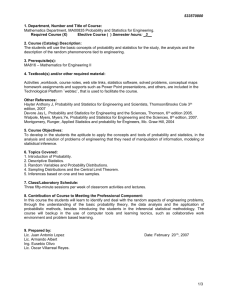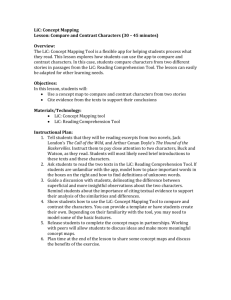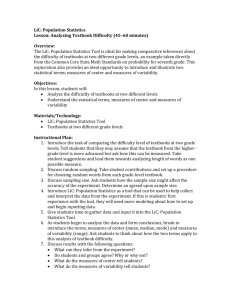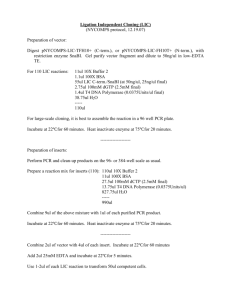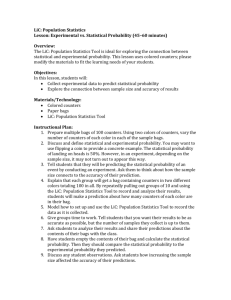This FAQ was produced by Sustainable
advertisement
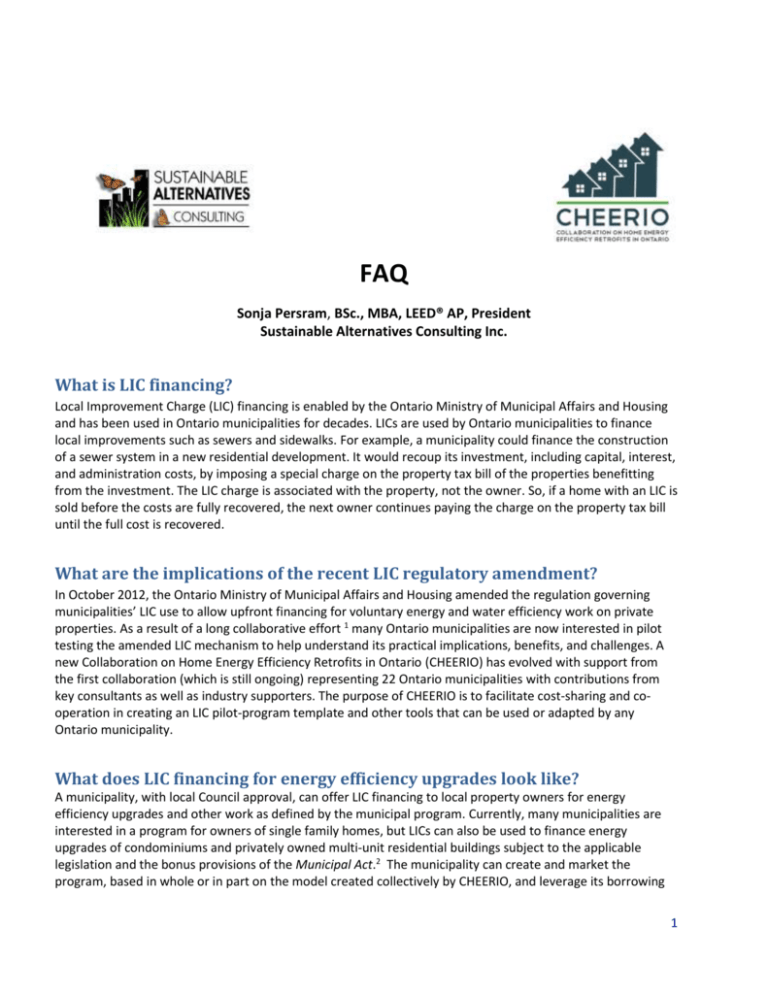
FAQ Sonja Persram, BSc., MBA, LEED® AP, President Sustainable Alternatives Consulting Inc. What is LIC financing? Local Improvement Charge (LIC) financing is enabled by the Ontario Ministry of Municipal Affairs and Housing and has been used in Ontario municipalities for decades. LICs are used by Ontario municipalities to finance local improvements such as sewers and sidewalks. For example, a municipality could finance the construction of a sewer system in a new residential development. It would recoup its investment, including capital, interest, and administration costs, by imposing a special charge on the property tax bill of the properties benefitting from the investment. The LIC charge is associated with the property, not the owner. So, if a home with an LIC is sold before the costs are fully recovered, the next owner continues paying the charge on the property tax bill until the full cost is recovered. What are the implications of the recent LIC regulatory amendment? In October 2012, the Ontario Ministry of Municipal Affairs and Housing amended the regulation governing municipalities’ LIC use to allow upfront financing for voluntary energy and water efficiency work on private properties. As a result of a long collaborative effort 1 many Ontario municipalities are now interested in pilot testing the amended LIC mechanism to help understand its practical implications, benefits, and challenges. A new Collaboration on Home Energy Efficiency Retrofits in Ontario (CHEERIO) has evolved with support from the first collaboration (which is still ongoing) representing 22 Ontario municipalities with contributions from key consultants as well as industry supporters. The purpose of CHEERIO is to facilitate cost-sharing and cooperation in creating an LIC pilot-program template and other tools that can be used or adapted by any Ontario municipality. What does LIC financing for energy efficiency upgrades look like? A municipality, with local Council approval, can offer LIC financing to local property owners for energy efficiency upgrades and other work as defined by the municipal program. Currently, many municipalities are interested in a program for owners of single family homes, but LICs can also be used to finance energy upgrades of condominiums and privately owned multi-unit residential buildings subject to the applicable legislation and the bonus provisions of the Municipal Act.2 The municipality can create and market the program, based in whole or in part on the model created collectively by CHEERIO, and leverage its borrowing 1 power to arrange attractive interest rates and terms, which individual property owners might not be able to secure on their own. Participation in the program is completely voluntary. Upon entering into an agreement with the municipality, participants could access financing for extended terms up to 20 years at a competitive fixed rate that would include a provision for administrative costs. This long-term financing can help homeowners finance larger, higher-impact upgrades. The participants repay the financing as a user fee on their property tax bill for the duration of the term. The LIC does not increase the owner’s property taxes. After the financing is repaid, the charge is removed from the property tax bill. If the owner sells the property before repayment is complete, the responsibility for repayment transfers to the new owner. Homeowners may choose to fully repay the financing when they sell their home, or earlier. The participants in the program – not the general taxpayer – share the cost of program administration. Program administration and set-up costs can also be offset by external funding, such as grants, or by sharing the cost of set up by collaborating with other municipalities in program design, evaluation, or other key set-up services. Why would a municipality undertake this type of program? Supporting energy efficiency in all sectors is the cheapest and fastest way to ease energy demand especially as municipalities grow, and helps offset the need for costly energy infrastructure development. Energy use in homes and buildings accounts for a significant portion of greenhouse gas emissions; addressing the energy efficiency opportunities in the built environment helps municipalities achieve established greenhouse gas reduction targets. People who invest in home energy upgrades reduce their energy bills and protect against energy price increases. In fact, participating home owners in the federal ecoENERGY home retrofit program saw an average energy savings of 20% after upgrading. These savings strengthen the local economy by creating new local employment and spending. Energy efficiency upgrades, especially in older housing, can significantly improve the quality of the local building stock. LIC financing can fill a gap in public support for energy efficiency upgrades. While some utility sponsored programs still remain, the successful Ontario Home Energy Savings Program and the federal ecoENERGY incentive program have ended and will not be renewed. LIC program costs are supported by the participants, not the general taxpayer, so the program pays for itself and does not add any operational costs to the municipality. Regulatory amendments permit the municipality to recover administrative, marketing, and other program costs directly from participants on a pro rata basis. Energy efficiency upgrades are labour intensive and energy upgrade programs provide a significant economic stimulus when carried out at a large scale.3 The American Council for an Energy Efficient Economy notes that in the construction industry there are about 20 jobs created per $1 million spent on energy upgrades, compared to half as many in power generation and distribution.4 How can municipalities finance an LIC program? Municipalities have a variety of options for financing LIC programs. For smaller programs, for example they can draw on internal funds, such as operating surpluses or capital reserves. This type of program might also qualify 2 for financing through Infrastructure Ontario, which provides a low-cost and flexible source of capital. Alternatively, municipalities can raise financing by direct borrowing from the bond market. Why would a property owner participate in this type of program? Investments in energy efficiency reduce energy bills, improve building comfort, and shrink carbon footprints. Some families cannot access financing at attractive rates. An LIC program removes upfront capital barriers that often impede energy retrofit investments. LIC financing has the advantage of offering longer repayment timeframes at fixed rates, making payments more affordable. LIC financing can be transferred to subsequent property owners, allowing the costs and benefits of the energy efficiency investment to be shared fairly between current and future owners. Retrofits can create healthier indoor conditions for occupants when they are less drafty and indoor temperatures are more comfortable.5 Improved home-energy performance can contribute to increased property value. In the United States, homes with an Energy Star label were sold at prices 9% higher than comparable non-labelled homes.6 7 8 What risks are associated with this type of program? Liability for faulty contractor work. The municipality’s potential liability for any damages due to defective work by independent contractors depends on the detailed structure of the LIC program and related contractual agreements. To mitigate this risk, municipalities should seek legal counsel for both program design and contractual agreements. Generally, contractors hold principal liability for any damages due to defective work; it is therefore advisable that municipalities require that contractors maintain appropriate insurance policies with adequate coverage of potential liabilities.9 Default on payments. Municipalities collect LIC payments in the same manner as property taxes. Any payment in arrears (and only the overdue amount) is subject to a special priority lien and may be recovered with costs by the municipality from both current and future owners of the property. Municipalities can mitigate the risk of defaults by screening participants or capping the amount of the LIC based on the estimated property value (e.g. no more than 10% of assessed property value). Administrative cost over-runs. Since LIC financing programs rely on economies of scale to spread administration costs over a sufficient number of participants, low uptake is a risk. Program design needs to clearly define and engage primary target audiences and must be supported with adequate marketing and outreach budgets. Program designers should ensure that any possible incentives are incorporated into the program to keep the offer attractive, and that suitable marketing partnerships are identified and mobilized with community groups, contractors, and local utility companies. Administrative costs need to be carefully managed and monitored and, where opportunities exist, municipalities should seek sponsorships or other external funding sources to offset the costs of set up and administration by external funding sources. Finally, estimates of pilot program enrollment should be conservative. Under-performance on greenhouse gas emissions reductions and energy savings. While allowing a wide variety of energy efficiency actions does create broader appeal, there is the risk that more popular options, like window replacements and photovoltaic systems, will not achieve significant greenhouse gas reductions for dollars spent. This can be managed by creating a tiered list of eligible measures, ensuring that participants 3 have a home-energy evaluation, and supporting access to reliable practitioners and products.10 This way the highest impact measures can be emphasized and implemented effectively. Lack of clarity on program impacts. LIC programs, especially in pilot stages, need an appropriate monitoring and verification protocol embedded in program design. Monitoring and reporting activities should be designed to achieve meaningful results at reasonable cost. Performance benchmarks should be reported throughout the pilot phase, not just at the end, allowing for the flexibility to adjust the program design as necessary. How can municipalities leverage LIC programs through partnerships? Lower program design costs through multi-municipality collaboration. The CHEERIO model allows development of a flexible set of program design and evaluation tools using a cost-sharing and co-creation approach to maximize municipalities’ limited financial resources and unlimited intellectual resources. Integrate programs with relevant offerings from government and utilities. Wherever possible, LIC programs should take advantage of incentives offered by other players. For example, Natural Resources Canada’s EnerGuide Rating System (ERS)11 is used as the technical backbone for many innovative Canadian financing programs. This standardized, Canada-wide system leverages the tools and marketplace knowledge that have been used to rate more than one million Canadian homes. Local programs can also integrate promotional and incentive programs through their local utility companies. Co-marketing. To keep communications costs manageable, and to ensure messaging is properly targeted, program designers should work with key stakeholders who can serve as marketing channels, including contractors, retail outlets, community groups, and utility companies. What kinds of measures can be included in the program? LIC financing is for capital costs (not maintenance). However, programs can support the cost of post-retrofit upgrades, such as repairing walls after insulation is installed. Financing can also be extended to the homeenergy evaluation service. Municipalities may also include water and energy conservation measures. The financing term cannot exceed the lifetime of the upgrades. The amended regulation provides considerable authority and flexibility for municipalities to define the scope of energy works. Possible measures include: Thermal envelope upgrades, ie insulation, new doors, and air sealing. Mechanical system upgrades, ie furnace and boiler replacements, water heaters, thermostats and control systems, drain water heat recovery systems, heat-pumps, and air conditioners. Water efficiency and water quality upgrades, ie low-flow aerators, shower heads, and toilets, downspout disconnection, backflow preventers, well cleaning, and septic tank replacement. Renewable energy systems, ie solar water heaters, photovoltaic electricity generation systems, and small wind generators. 4 Who is using LIC for energy upgrades and what are they learning? Property Assessed Clean Energy (PACE) financing, a similar mechanism to LICs, has been in use in the U.S. since 2009. There are also PACE programs now being run by Efficiency Maine and Efficiency Vermont . In Canada, Halifax Regional Municipality offers a turnkey solution that including LIC financing in its Solar City program. The program was launched in 2013 to install 1,000 solar water heating systems. The City of Vancouver’s Home Energy Loan Program, launched in 2012, is a parallel approach with financing attached to the property on title and repaid on property tax bills. The program has since been cancelled due to challenges related to program design. Dunsky Energy Consulting analyzed PACE and LIC programs and established five key program principles based on the programs’ successes and failures: Know your audience. Create sufficient marketing resources. Keep the program simple. Ensure that the financing is as attractive as possible. Incorporate appropriate whole-house energy assessment. Who produced this FAQ and how can I use it? This FAQ was produced by Sustainable Alternatives Consulting for the Collaboration on Home Energy Efficiency Retrofits in Ontario (CHEERIO). The FAQ is intended to assist municipal decision-makers in understanding the use of local improvement charges to support the cost of energy efficiency and other improvements on private property. Municipal representatives may use and edit this document to assist in educating local constituents on this matter. We request that the authorship by Sonja Persram, President of Sustainable Alternatives Consulting for CHEERIO be acknowledged by municipal representatives when using all or part of this information. All others (including those under contract to municipalities) are required to appropriately reference and acknowledge this material’s authorship and its co-ownership with the Toronto Atmospheric Fund. For more information contact Mary Pickering at mpickering@tafund.org (416) 392-1217 or Sonja Persram at sonja@sustainablealternatives.ca (416) 324-9388. How can I learn more about this topic? This LIC FAQ is one of several documents in this series. You may also be interested in the LIC Primer document, the LIC Legal Briefing Note, LIC Program Evaluation Qualitative Research Study and the LIC Program Design Guidelines. 1 This long-term collaboration was developed by Sonja Persram since 2009 during and after a project for the David Suzuki Foundation. It helped to bring about the LIC regulatory changes and aimed toward pilot development. This collaboration included consultations with all levels of government, including 28 engaged municipalities in Ontario and 22 more that were interested; and contributions from leaders in all related industry sectors. Three reports she wrote on this topic are useful resources: Persram, Sonja, Property Assessed Payments for Energy Retrofits: Recommendations for Regulatory Change and Optimal Program Features, copyright David Suzuki Foundation and Sustainable Alternatives Consulting Inc., March, 2011; Persram, Sonja, Property Assessed Payments for Energy Retrofits and Other Financing Options, copyright David Suzuki Foundation and Sustainable Alternatives Consulting 5 Inc., May, 2011; Persram, Sonja, Strategic Recommendations for an Optimal “PAPER” Program, copyright David Suzuki Foundation and Sustainable Alternatives Consulting Inc., August, 2011. 2 Verbal opinion by Stanley M. Makuch, Barrister & Solicitor, April 2013. O.Reg. 322/12. See also the written opinion by John Mascarin, Aird & Berlis, April 29, 2013. 3 Copenhagen Economics, Multiple benefits of investing in energy efficient renovation of buildings: Impact on Public Finances, October 2012. 4 Additionally, by substituting labour-intensive energy upgrades for gas and electricity imports, less money leaves local economies. Bell, Casey, How Does Energy Efficiency Create Jobs?, American Council for an Energy Efficient Economy, Nov. 2011. 5 World Health Organization, Health in the green economy: Co-benefits to health of climate change mitigation: Housing sector, 2011. 6 Kok, N., & Kahn, M., The Value of Green Labels in the California Housing Market: An Economic Analysis of Green Labeling on the Sales Price of the Home, July 2012. 7 Kahn, M. & Kok, N., The Capitalization of Green Labels in the California Residential Housing Market, Feb. 2013 8 42% of homeowners in Toronto’s market research said they would purchase an energy efficient home with an outstanding energy efficiency loan, lower monthly bills, and higher resale value. 9 See the legal opinion by John Mascarin, Aird & Berlis, op.cit. note 2. 10 The Economist, The Elusive Negawatt, May 8, 2008. 11 This information is from Natural Resources Canada staff, personal communication with Sonja Persram, March 7, 2013. 6
